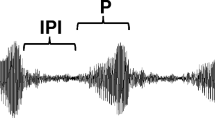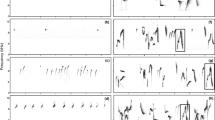Abstract
Avian vocalisations often show patterns of geographic variation. Previous work on the satin bowerbird has shown that although spatial variation in this species’ advertisement calls is strongly associated with habitat structure, some variation is apparent within habitat types. Seventeen populations located throughout the species’ distribution were used to examine whether spatial call variation could be influenced by other processes such as random drift or the presence of fine-scale vocal traditions; if this were the case, differing call variants would be expected at geographically discrete sampling sites both within and among habitat types. There were population-specific call variants at each of the sites sampled, with different variants apparent even within habitat types. At most sites, individuals gave only a single variant of advertisement call, and the call variant at one site, sampled after a 5-year interval, appears to have been relatively stable. Playback experiments were conducted at three populations to examine whether local call variants invoked a greater response than several non-local variants differing in their degree of similarity to the local variant. Birds responded strongly to local call variants but not to either of two foreign variants, one of which was similar to their local variant and one of which was very different. A pattern of geographic variation across populations, the fact that local and non-local variants evoke different responses and circumstantial evidence indicating that individuals can learn new calls all suggest that factors affecting song learning and the ability of males to establish and defend a bower site may have contributed to the establishment of geographically variable vocal cultures in this species.




Similar content being viewed by others
References
Baker MC (2000) Cultural diversification in the flight call of the ringneck parrot in Western Australia. Condor 102:905–910
Baker MC (2001) Bird song research: the past 100 years. Bird Behav 14:3–50
Baker MC, Baker EM, Baker MSA (2001) Island and island-like effects on vocal repertoire of singing honeyeaters. Anim Behav 62:767–774
Baptista LF, Johnson RB (1982) Song variation in insular and mainland California brown creepers (Certhia familiaris). J Ornithol 123:131–144
Borgia G (1985) Bower destruction and sexual competition in the satin bowerbird (Ptilonorhynchus violaceus). Behav Ecol Sociobiol 18:91–100
Borgia G, Gore MA (1986) Feather stealing in the satin bowerbird (Ptilonorhynchus violaceus): male competition and the quality of display. Anim Behav 34:727–738
Bradbury JW, Cortopassi KA, Clemmons JR (2001) Geographical variation in the contact calls of orange-fronted parakeets. Auk 118:958–972
Charif RA, Mitchell S, Clark CW (1995) Canary 1.2 user’s manual. Cornell Laboratory of Ornithology, Ithaca, NY
Christie PJ, Mennill DJ, Ratcliffe LM (2004) Pitch shifts and song structure indicate male quality in the dawn chorus of black-capped chickadees. Behav Ecol Sociobiol 55:341–348
Diamond J (1986) Animal art: variation in bower decorating style among male bowerbirds Amblyornis inornatus. Proc Natl Acad Sci USA 83:3042–3046
Endler JA, Westcott DA, Madden JR, Robson T (2005) Animal visual systems and the evolution of color patterns; sensory processing illuminates signal evolution. Evolution 59:1795–1818
Handford P (1988) Trill rate dialects in the rufous-collared sparrow, Zonotrichia capensis, in northwestern Argentina. Can J Zool 66:2658–2670
Harbison H, Nelson DA, Hahn TP (1999) Long-term persistence of song dialects in the mountain white-crowned sparrow. Condor 101:133–148
Irwin DE, Bensch S, Price TD (2001) Speciation in a ring. Nature 409:333–337
Kroodsma DE, Baylis JR (1982) Appendix: a world survey of evidence for vocal learning in birds. In: Kroodsma DE, Miller EH (eds) Acoustic communication in birds, vol. 2. Academic, New York, pp 311–337
Kusmierski R, Borgia G, Uy A, Crozier RH (1997) Labile evolution of display traits in bowerbirds indicates reduced effects of phylogenetic constraint. Proc R Soc Lond B 264:307–313
Leitner S, Voigt C, Gahr M (2001) Seasonal changes in the song pattern of the non-domesticated island canary (Serinus canaria), a field study. Behaviour 138:885–904
Lynch A (1996) The population memetics of birdsong. In: Kroodsma DE, Miller EH (eds) Ecology and evolution of acoustic communication in birds. Cornell University Press, Ithaca, NY, pp 181–197
Marshall AJ (1954) Bowerbirds: their displays and breeding cycles: a preliminary statement. Clarendon, Oxford
Matthysen E (1997) Geographic variation in the occurrence of song types in nuthatch Sitta europaea populations. Ibis 139:102–106
Maxwell PS, Robson TE, Goldizen AW (2004) Home-range sizes and bower visitation patterns of immature male satin bowerbirds (Ptilonorhynchus violaceus). Emu 104:75–77
McArthur PD (1986) Similarity of playback songs to self song as a determinant of response strength in song sparrows (Melospiza melodia). Anim Behav 34:199–207
McGregor PK, Catchpole CK, Dabelsteen T, Falls JB, Fusani L, Gerhardt HC, Gilbert F, Horn AG, Klump GM, Kroodsma DE, Lambrechts MM, McComb KE, Nelson DA, Pepperberg IM, Ratcliffe L, Searcy WA, Weary DM (1992) Design of playback experiments: the Thornbridge Hall NATO ARW consensus. In: McGregor PK (ed) Playback and studies of animal communication. Plenum, New York, pp 1–9
Morton ES (1975) Ecological sources of selection on avian sounds. Am Nat 109:17–34
Mundinger PC (1979) Call learning in the Carduelinae: ethological and systematic considerations. Syst Zool 28:270–283
Mundinger PC (1982) Microgeographic and macrogeographic variation in the acquired vocalizations of birds. In: Kroodsma DE, Miller EH (eds) Acoustic communication in birds, vol. 2. Academic, New York, pp 147–208
Nelson DA (1998) Geographic variation in song of Gambel’s white-crowned sparrow. Behaviour 135:321–342
Nelson DA, Khanna H, Marler P (2001) Learning by instruction or selection: implications for patterns of geographic variation in bird song. Behaviour 138:1137–1160
Nelson DA, Soha JA (2004) Perception of geographical variation in song by male Puget Sound white-crowned sparrows, Zonotrichia leucophrys pugetensis. Anim Behav 68:395–405
Nicholls JA, Austin JJ, Moritz C, Goldizen AW (2006) Genetic population structure and call variation in a passerine bird, the satin bowerbird, Ptilonorhynchus violaceus. Evolution 60:1279–1290
Nicholls JA, Goldizen AW (2006) Habitat type and density influence vocal signal design in satin bowerbirds. J Anim Ecol 75:549–558
Nix HA (1993) Bird distributions in relation to imperatives for habitat conservation in Queensland. In: Catterall CP, Driscoll PV, Hulsman K, Muir D, Taplin A (eds) Birds and their habitats: status and conservation in Queensland. Queensland Ornithological Society, Brisbane, pp 12–21
Pepperberg IM (1994) Vocal learning in grey parrots (Psittacus erithacus): effects of social interaction, reference, and context. Auk 111:300–313
Price JJ (1998) Family- and sex-specific vocal traditions in a cooperatively breeding songbird. Proc R Soc Lond B 265:497–502
Schodde R, Calaby JH (1972) The biogeography of the Australo-Papuan bird and mammal faunas in relation to Torres Strait. In: Walker D (ed) Bridge and barrier: the natural and cultural history of Torres Strait. ANU, Canberra, pp 257–299
Searcy WA, Nowicki S, Hughes M, Peters S (2002) Geographic song discrimination in relation to dispersal distances in song sparrows. Am Nat 159:221–230
Slabbekoorn H, Smith TB (2002a) Bird song, ecology and speciation. Philos Trans R Soc Lond B 357:493–503
Slabbekoorn H, Smith TB (2002b) Habitat-dependent song divergence in the little greenbul: an analysis of environmental selection pressures on acoustic signals. Evolution 56:1849–1858
StatSoft (2003) Statistica (data analysis software system), version 6. StatSoft, Tulsa, OK
Tack EJ, Robson TE, Putland DA, Goldizen AW (2005) Geographic variation in vocalisations of satin bowerbirds, Ptilonorhynchus violaceus, in south-eastern Queensland. Emu 105:27–31
Thielcke G (1973) On the origin of divergence of learned signals (songs) in isolated populations. Ibis 115:511–516
Thielcke G, Wustenberg K (1985) Experiments on the origin of dialects in the short-toed treecreeper (Certhia brachydactyla). Behav Ecol Sociobiol 16:195–201
Trainer JM (1989) Cultural evolution in song dialects of yellow-rumped caciques in Panama. Ethology 80:190–204
Uy JAC, Borgia G (2000) Sexual selection drives rapid divergence in bowerbird display traits. Evolution 54:273–278
Vehrencamp SL (2001) Is song-type matching a conventional signal of aggressive intentions? Proc R Soc Lond B 268:1637–1642
Vehrencamp SL, Ritter AF, Keever M, Bradbury JW (2003) Responses to playback of local vs. distant contact calls in the orange-fronted conure, Aratinga canicularis. Ethology 109:37–54
Westcott D, Kroon FJ (2002) Geographic song variation and its consequences in the golden bowerbird. Condor 104:750–760
Wright TF (1996) Regional dialects in the contact call of a parrot. Proc R Soc Lond B 263:867–872
Acknowledgements
I thank E. Tack and D. Westcott for the use of their recordings, numerous landowners for permission to work on their land, H. Rodgers, H. Gunter, A. Nicholls, A. Nelson, E. Parks and K. Arhangelsky for their assistance in the field and A. Goldizen, J. Austin and C. Moritz for encouragement and supervisory support. A. Goldizen, J. Scarl, D. Pavlacky, J. Endler, L. Joseph, the UQ Behavioural Ecology Research Group and several anonymous reviewers commented on earlier drafts of the manuscript. For financial support, I thank the National Science Foundation (grant to C. Moritz), Birds Australia, the Gould League of NSW and the Ecological Society of Australia. All recording and playback protocols were approved by the University of Queensland Animal Ethics Committee.
Author information
Authors and Affiliations
Corresponding author
Additional information
Communicated by J. Podos
Rights and permissions
About this article
Cite this article
Nicholls, J.A. Site specificity in advertisement calls and responses to playbacks of local and foreign call variants in satin bowerbirds, Ptilonorhynchus violaceus . Behav Ecol Sociobiol 62, 831–841 (2008). https://doi.org/10.1007/s00265-007-0509-9
Received:
Revised:
Accepted:
Published:
Issue Date:
DOI: https://doi.org/10.1007/s00265-007-0509-9




